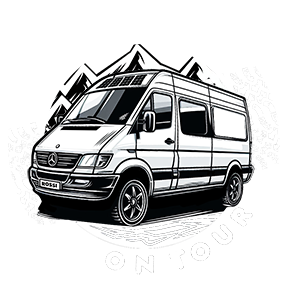NAMIBIA
[google_map_easy id="40"]
Namibia Tour, 2019/2020
Namibia - A Comprehensive Overlanders Guide
Namibia is our 7th african country and I must admit, that I personally never really wanted to go there.
It may be up to all those "strange" Facebook-Groups, or because it's a german colony, or this never ending vastnesses, the huge distances or the fact, the Namibia is more of a desert, rather than sort of paradise.
Or maybe my afraidness of the wildlife?... I really don't know anymore.
But glad me - it turned out so different 🙂
Namibia is as double as big than germany, but only counts a population of about 2.6 million people.
So lots of space for an individual person. This fact comes with long, very, very long distances.
So if you'll need to drive 5 KM in germany for the next supermarket, you'll need to drive at least 50 or 250KM for just getting a few tomatoes, potatoes and some slices of bread.
That's not joke, as exactly this happend, when we were staying at the Roadside Camp close to the Etosha, when a guy called Luigi needed some vegetables for dinner and drove 70 KM for those.
Once you'll get used to this distances (which you'll always need to drive), Namibia is suddenly kind of shrinking and we were astonished, that at a certain point we rarely thought about the distances anymore.
First then your way may become your goal.
And first then Namibia will offer its true beauty and this beauty is just fabulous.
I might have written it in other blogs and for other countries already, but also Namibias landscapes are a true epic wonder. Whether you're driving the Gamsberg Pass, enjoying the lovely Hakos Mountains, or you're heading to the Fishriver Canyon or the skeleton coast, the Etosha National Park or the Sossusvlei.
Beauty all around, whether in terms of landscapes or Namibias wildlife.
But even (or especially) in Namibia one needs to know, what to expect when overlanding through this more or less rough african country.
So here's kinda guide for those, who are searching for their li'l own paradises, their adventures, their landscapes to photograph or whatever you're supposed to experience.
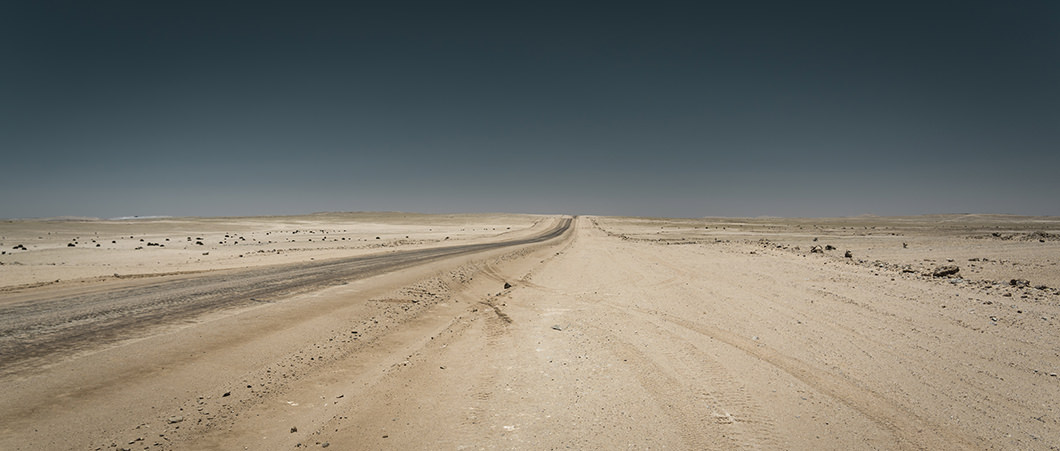
Namibias Landscapes And Temperatures
Namibia is mostly kind of a huge desert and actually suffers from a huge drout since several years, so there are basically just 2 rivers (Cunene in the north and the Oranje river in the south), which have water. The rest is totally empty... no water at all.
In the north at the Caprivi strip along the Angolian border straight to the west, you'll find it mostly green, as in December it's rain season in Angola, which kind of swaps over to Namibias north.
You'll get more or less heavy rain from here to there, but the temps have an average of approx. 29°C.
The Cunene river is filled with water and we highly suggest to drive the new gravel road from Ruacana to the Epupa Falls. This is actually and unfortunately the true one and only real "paradise" in Namibia.
Stop at "Cornies Camp" either for an ice cold beer or for a night stay. You won't regret!
(greetings to Cornie and Tia and maybe they'll take you on a ride to "their" both 5m long crocodiles 😉 )
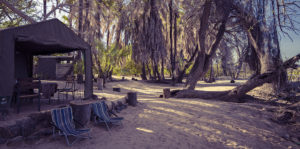
The further you'll get down to the middle, the hotter it'll get.
At the Etosha National Park we had 41°C already. The landscape here is salty and deserty. The roads are very dusty and dry. Pay attention to your driving, but this is a later topic.
At the Skeleton Coast in the west you'll be surprised by moonish landscapes and very strong winds. The temps will go down to r.a. 19°C (which may feel colder because of the winds).
If you'll drive down the complete coast all the way, passing Hentis Bay, Swakopmund, Walvis Bay, down to the most southern city, called Oranjemund, you maybe (or for sure), will be disappointed, if you're searching for some nice beach days.
There is just-> none.

Nor shady places, neither kinda Oasis, less camps (which are pretty much crap), strong winds and ice cold water and I must say, it's the coldest atlantic ocean, I've ever experienced.
That might be the reason, why there's basically not really a nice camp. There is the "Mile 108" from which they told us, it should be cool, but jeeezuz. NO!... definitely not, except you like hundreds of fishers, who are camping there, making noise and taking care of there permanently running generators.
Apart from their ablutions (no more words needed 😉 )
Anything else along the complete coast is basically "dead" and this has been the only place where we felt, that we completely wasted our time.
OK, maybe Hentis Bay, which is a nice village and Cape Cross, where are hundreds of thousands of seals, but if you don't wanna experience dead and the smell of dead: do not drive there.
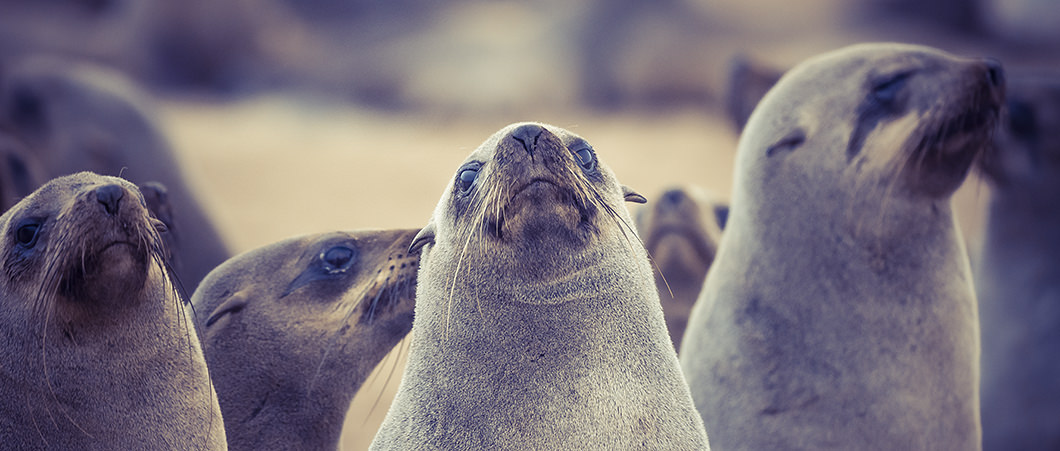
In the "middle-middle" there's the Namib desert and the Namib-Naukluft National Park. It contains the Hakos mountains, the Gamsberg and their passes (Spreetshoogte Pass and the Gamsberg Pass).
Whereas the first one is boring, the Gamsberg Pass is just WOW.
Temps here are also pretty hot, up to 39°C, but in average I would say 35°C.
In the east of Windhoek you'll find the Kalahari desert.
Well... it's a desert and we drove through... nothing really special, just as one would expect.
Temps here are also pretty high: up to 40°C
In the south you'll experience even more vastnesses without lots of infrastructures.
Rehoboth, Mariental and Keetmanshoop are the bigger cities, but inbetween there's just nothing, but deserts and flat lands and we found it really boring, until you'll reach the Fish River Canyon.
This one is one of the biggest canyons in the world. Not really comparable to the Grand Canyon (it's just a fraction of the american one), but nevertheless a place you shouldn't miss.
Temps have been super fine here: 28°C avg.
Tipp: There are a few viewpoints: The north for the sunrise and the 15KM more south for the sunset. Both are worth a visit.
A drive along the Oranje river even more in the south, won't disappoint you. Btw: lots of wild camping opportunities here, but this later 🙂

Wildlife
Of course this is one of the main reasons, why people are visiting Namibia and yes, it also was our main reason, even if we'd see all those animals (esp. the "Big Five") in the Kruger National Park already.
Wildlife in Namibia is definitely not comparable to a zoo or a special built area like wildlife parks in germany.
Wild animals are basically everywhere in Namibia. So it will happen that a giraffe or an elephant herd is suddenly crossing your way or that a Hyena is visiting your camp, if you dare to bushcamp in the wild. They also may appear, when you're staying on an established campground. In bigger villages or cities, you won't see animals, though.
The Etosha National Park
The most animals you are able to see, are in the Etosha National Park, of course. But the Etosha is (much too) huge as it spreadens 200 KM from the east to the west and you'l need to drive a lot.
The reward will be hundreds of different animals like zebras, leopards, elephants, lions, hyenas, gemsbok, springbok, oryx, and dozens of mammals more. The costs of the Etosha will be around N$ 80p.p and there are several gates, where you can get into (or out of) the park.
The "Von Lindequist Gate" in the east (which we used), the one in the middle south (Anderson Gate) and the Galton Gate in the west, where we departed from the park after 3 days. There's another one in the north (King Nehale Lya Mpingana Gate) , which we don't know, though.
TIPP: The Galton Gate IS accessible by the public, even if their website says, that it's just for residents or people who booked in into the nearby campsite.

There are also several campsites and lodges inside the park, which are pretty expensive, but we would stay at least for 2 days in the Etosha. In December there's less tourism, so you won't need to book, as we didn't book either.
The max. speed inside the park is 40 km/h, which is crucial as there already people died by animal collisions.
Another Tipp (and we liked it much more) is the Bwabwata National Park, at the Caprivi strip.
We started our journey in Windhoek and headed directly to Botsuana, driving up to the north to the Okavango Delta.
When we left the delta and crossed the border to Namibia again, we immediately found us in the National Park, without even knowing it.
The park is tiny, compared to the Etosha, but you'll see so many animals and even water buffalos, rhinos and some other species, we didn't see in the Etosha.

But as I've written before: animals are all around.
You probably won't be surprised by a lion herd outside such a park, but zebras, elephants, giraffes, oryx, etc. will cross your way for sure.
If you plan to stay in the wild, always keep an open eye for animals poo, lots of bones from ripped off animals, footprints of animals like elephants and all other indications, which may point to animals.
I tend to say, it won't be sexy, if in the morning you'll wake up at a waterhole and a bunch of elephants is already having their breakfast 😉
These animals are wild and could be really dangerous, especially when they've got young babies aside or if they can't reach their bases and/or their waterholes.
So make sure, you're not standing in their daily way to their water or whatever.
If you like those kind of animals around you: always stay calm and do not get afraid.
And if an animal comes towards you, do not run, stay calm and start to begin your pullback slowly but surely.
If you're getting afraid and hectic, you'll trigger the animals hunting instinct and they might will attack you.

Zebras, giraffes, antilopes and a lots others are mostly very shy.
They won't come too close to you, they rather keep a bigger distance, if they see you.
But even here: keep distance, as at a certain point even those animals could attack you.
Baboons are all around, sometimes more, sometimes less.
Most of them are afraid of people and they will keep distance, others aren't shy in any way, they might come very close, they even try to steal your belongings and you coud even find them inside your car.
When you see crocodiles, lions, leopards, hyenas or some similar predators: never ever get out ouf your car, especially when they are very close.
If they are not so close, there might be some others away from the ones you'd see - anywhere in the bush - and we had it several times with elephants.
We also had a lions herd with 2 "ladies" and 3 babies directly in front of our car. What would you do, if someone might could attack your babies?
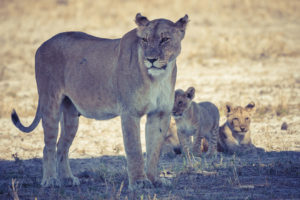
We never bbq'ed meat in the evening and always tried to get finished with dinner before sunset and we never let rubbish outside the car, especially not meat, bones and fruits.
We always observed our surroundings in a diameter of 100 meters or so (see above) and we always have been "active", which means sort of "loud", just to "warn" the animals, that there are humans.
If you are too calm (which we usually prefer), animals might come very close and at a certain point they might become curious.
These animals are not really interested in humans and if they hear them, they rather keep distance... but you never know 😉
We always weared closed shoes, especially where lots of stones and rocks were lying, as I personally accidently nearly stepped onto a "Hornotter" (which is poisonous and can be leading to death) and 2 scorpions.
So do not take stones (for leveling your car or for a wildfire), without being very carefull. Scorpions are mostly lying underneath them, as well as snakes.
For snakes it shall be good to stamp your feet on the ground as they feel the vibration and will disappear.
All in all Namibians wildlife is very active and beautiful and we loved it so much to wake up in the morning and a family of giraffes in 100m distance is lying on the ground under a shade giving tree 🙂

Namibian Roads, Traffic, Gas Stations And The Police
Namibians tend to say, that their roads are so unbelievable bad.
No-> That is not true and do not be afraid, as we were.
You do not need special skills to drive them, nor you really need a fully rugged 4x4.
You just need a bit patience, caution, practice, a reliable car and good tires. And keep in mind: Namibia has left-hand traffic.
If you're experiencing the whole Namibia, you mostly will find yourself driving on gravel roads, lets say 85%.
These roads are surprisingly much better than expected. They are mostly not as currogated as in Argentina for instance, they're rather soft with fine gravel and they're super wide, so mostly not in any way too narrow.
Some roads (like in the Gamsberg area, in the Etosha, in direction to the Skeleton Coast or in the Fishriver Canyon area) are a little bit more currogated and "harder" to drive, but nevertheless I'd say, that most roads in the Western Alps are worse than the ones in Namibia.
There are gravel roads, where you're even allowed to drive 120 km/h and that's totally possible indeed.
Most of them are easily drivable with 90-110 km/h, some of them only allow 80 km/h.

The tarred roads (i.e. to Swakopmund, around Windhoek and/or Mariental or down to the Fishriver Canyon in the west) are just superb. No complaints at all.
But (and there's always a "but"), there are some (hidden) drawbacks: Temperatures, Tire Pressure, Load and Tire Quality. If you knowing the dependencies between each other, you won't run in any problem. If you don't, you'll end up with (at least) punctures or in the worst case: blown up tires (we had two)
For the "tire-problem", read carefully here (coming soon)
For the punctures there's just one hint: Keep Distance.
Namibia has this billions of "thorn trees" or "thorn bushes".
These thorns can become as thick as a little finger (but are mostly around 3-5 cm long and r.a. 2-3mm thick) and they're lying all around, especially at the left and right of the road.
So if you're stopping for a picnic or whatever, watch out for this trees or bushes and keep distance to them.
When driving through Namibia, you'll see hundreds of "tire repair shops" from super basic to kinda highend equipped. And that's for a good reason.
We ourselves had 3 punctures and others we talked to, had even much more.
If you're not going offroad (we didn't), you may won't run in any problem, but when going offroad (like on the Van Zyls pass), of course even worse damage can occur to your tire, but that's a different story and every offroader might know or experienced it already 🙂

Local Namibians and tourists are driving more or less carefully, there are basically no traffic jams, nor people, who are driving like insane. No matter if on the land, in the villages or cities.
Namibia has lots of gas stations and we never had any problem with stations that hadn't Diesel anymore, but for those very long distances it might be good to have a car with a double tank system, like we had.
In this case, a distance of nearly 1000 KM has been possible, just in case there's a station without gas.
The police in Namibia is present and that's good.
From time to time and especially close to the borders to Botsuana, Angola i.e., or where a Namibian district changes, there are those Police Checkpoints. They either just check your personalities, asking you, where you're coming from and where you're going to... thats all.
Do yourself a favour and always stop at the stop sign (even if they are waving you through), be buckled up (we paid 65€ for not being buckled up), turn your headlights on and do not drive faster on tarred roads as allowed. Namibia has speed cameras and officers, who measure your speed with laser-cannons.
The other checkpoints are checking your fridge for fresh meat, so meat, that isn't packaged. As for the prevention of viruses or whatever kind of bacterias, getting from one district/country to another, they will ask you to destroy the meat or just get rid of it.

Money, Internet And Mobile Communication
Namibias currency is the Namibian Dollar (N$).
You may change your currency into N$ directly at the airport and here's the hint:
There's one shop (less visited, as you may observe) which takes a commission on top. The other shop won't take a commission. Just watch for the Stewardesses, they will go to the "better" shop 😉
Namibia has 2 telecomunication services: MTC and Namibian Telecom. In all Namibia we only had 2 cities (around Mariental), who seem to rely on Namibian Telecom, the rest was more or less good covered by MTC. As long as you will mostly stay close to the main roads, you'll have 3G up to H+, but once you leave the bigger villages, cities and/or main roads, your connection may go down to zero.
MTC - The Way To Go
At the airport there's a shop from MTC, where you can get these so called "Super Aweh" Vouchers, from which we bought five for our five weeks. Every voucher is valid for one week, gives you 700 MB of Facebook and Whats App amount as well as 3 GB of data volume on top. You will get an own phone number with an amount, from which we don't kow, how high it was, as we only used it for callig the Rental Car Company. Additionally 15o0 free SMS are included, btw.
For this 5 vouchers we paid N$ 325, which is 20,64€, so pretty cheap 🙂
At the MTC shop just ask for the voucher, hand your smartphone to the service-guy, who will register your phone in no time.
After the first voucher isn't active anymore, you just need to send an SMS with the next voucher code to MTC and your new data amount will be activated. If it doesn't work immediately, do not hesitate to call the given number, the service is great and helped us within seconds.
MTC Recommendation: TOP!
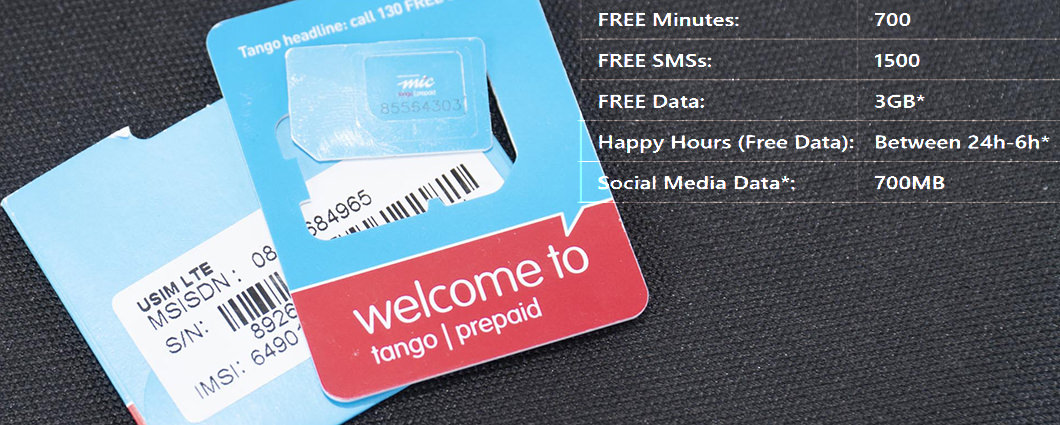
People, Language, Security, Crime and Beggars
All people in Namibia - no matter if black or white, yellow or green, foreigners, strangers, beggars or (most of the ) tourists - have been really nice, helpful and supportive.
The spoken languages differ from district to district, but English and Afrikaans are spoken everywhere.
Additionally to that, they've got several other languages from which we only know the Himba, but there are several other native tribe-slangs.
Every single person has been very communicative, so we've got dozens of super nice chats, smalltalks and intense exchanges of informations. We loved it!
Security seems to be a hot topic all over the world and mostly it's not that bad, as others will tell you.
We never had bigger incidents, just one time in Ireland and yes... the other one in Windhoek.
Generally you can feel very safe in Namibia and every single person has been nice (even the scoundrels 😉 ).
If your out of the cities and/or bigger villages, the safety is very high. We mostly locked our cars, but there also were places, where we just didn't feel the necessity of keeping everything safe, but it always depends on where you are.
In the north of Namibia (at the Caprivi strip) we felt very safe.
The local people have been super friendly and even the very poor people have been very shy and reserved and didn't beg. They just tried to make some nice conversation in hope, you give them some food, but they did not ask.

The more you'll get down, the more beggars will wait for you and if you do not like beggars or just don't wanna mess around with them (I had lots of conversations as well as arguments with them), pass the following cities: Opuwo, Outjo, Kamanjab and Otjiwarongo.
Here are the most aggressive beggars (and btw: run away from the Himbas 😉 )
They start to make you compliments and then asking for your names. They immediately start to put your name on chestnuts or whatever and then offering you the stuff for horrendous money.
Now you've got two choices: Just leave the place immediately or get an argument with them.
I told them, that it's one thing, to beg. The other thing is to offer something selfmade and the third is, to believe, that even those so called "rich germans" are stupid enough to pay 10€ just for a chestnut.
The most important thing is: be very, very friendly, show empathy, feel with them and their situation.
Surprisingly I had much more success, with making them understand, that even a german isn't always rich, rather than just saying: no, thank you.
Otherwise they just ignore you and they're getting even more motivated to convince you... they just DO NOT STOP 😉
HIMBAS
The Himbas in this area are most "aggressive" or lets say "motivated".
Himba is one of the namibian tribes, where the women got those clayey hair and who do not know Bra's, so they come towards you (more or less "well breasted") and begging the hell outta you 😀
As they do not speak english (or mostly not), they just talk and beg and talk and beg.
The only chance for us was, to just leave the place, because if one of those ladies checked you out already, 20 others may come.

Be Careful In Windhoek
If you then get more to the south, the less the begging will be.
Not because the people are "nicer", but because the population (especially of tribe members) will decrease.
We had some guys here and there, begging for water and as we always had a full tank, we always gave them a few litres.
When entering big cities like Windhoek: Keep your eyes wide open and do NOT trust ANY other people, than yourself and your partner!!!
"Black people are clever", they told us. And it didn't matter, if it was the "black or white" Police or the "black or white" local, who always told us about it!
And yes... they indeed are. But not clever enough, though 😉
We were standing on a hill above Windhoek, at a not really well known viewpoint, but with a nice view onto the whole city.
I made some photos and a (white) guy (maybe some official) came along in his SUV:
"Hey there (smalltalk): PLEASE! be very carefull. This road is wellknown for criminla gangs, who rip everything they can get, so always keep an open eye and do not stay here for too long!"
It just took further 15 minutes and two guys (looked like a couple) came along, straight towards us.
I grabbed my camera rig and wanted to put it into the car (whose windows already have been covered by towels)
They - a young skinny man and a slightly bigger young lady (maybe 32 or so) - immediately began to ask:
"Hey, what are you doing here?" (he immediately showed me his police identity card and put it away a bit too fast)
"We're tourists obviously and I wanna shoot some photos"
"You're not safe here, did already some guys came along"? the guy asked.
"Yes, one white guy, with short hair in his SUV, wearing a shirt with "Angola" on it. He warned us as well".
She (immediately): "That was one of these guys, whose trying to ripping you off".
I: "He did look like an official from some kind of business and looked very serious".
She (began to talk without an ending).
He (began to talk without an ending).
Sonja (smelled the rat already ): "Honey, I would say, we should drive immediately" (I felt the same and was grabbing my camera)
She: "please take your photos, we're already observing you with a camera, which is installed there" (and pointed to a certain place).
I: "Thanks so much for warning me, but now I'm a bit afraid, we'll leave now".
She: "Nonono, take your time".
I (already had such a strange feeling, reason later 😉 )
She (talking like a waterfall)
He (grabbed his private phone in a golden cover) and talked in english: "Hi, yes... we are here... can you see us? They're just tourists and wanna take photos, it'll take further 25 min)
Sonja: (calm, but kinda strong): "Please, honey, let's got IMMEDIATELY"
I (closed the doors): "Thank you so much for caring about us tourists, you're doing a great job, but we leave now.
He and She: "no problem, you can trust us, we are police officers, here are our weapons and again my identity card" (the guy showed it) .
Boom! That was the initial gesture to leave immediately!
So! That was the conversation part.

Now, our observation part:
- Both of them came in an old Nissan Pickup (no police lights, no decals)
- He grabbed a private old smartphone in a golden cover (officers always use Walky Talkies!)
- She showed her big boobs way too much (huge neckline for distraction, because of face recognition)
- Both talked and talked (playing for time)
- He talked to his office in english, so that we were able to understand (they always talk in Afrikaans usually)
- Both were privately dressed... way too good, even for officers.
- Why they have been undercover? (we never saw any officer without official dress and official car)
- Why they asked, what we were doing here, when they observed us as obviously ugly clothed and dirty, photographing tourists already?
- The guys talk to the "office" was way too placative.
- She always said, "black people will attack you, even with their weapons", but the first guy from whom she told me, he was supposed to mug us, was white.
- Does a Police officer really showing off his/her weapons?
- The weapons weren't in a holster, rather than "gangster-styled" between trousers and skin (the ladys gun at the butt, guys gun at the dick)
- Why they 2 times tried to convince us to further photograph?
- Sonja told me, that when he was calling his guys, he heavily observed the inside of the car (I did see it also from my eyes corner).
- She also told me, that the "hand-shaking" was kinda "gangsta-style" and exactly how adolescents do it in germany too.
Conclusion
I really think, you already know, what we're up to and you should be able to imagine, what their purpose was.
They should act like policemen to make us feel save and to stay.
As we saw their faces already, they didn't want to mug us, as well as "her boobs" could have been an diversionary tactic , so that I more look at her boobs instead of their faces.
Sonja btw. was sitting in the car and rarely able to see their faces. They also parked their car directly in front of ours.
They told their guys, that they've got 25 minutes until we leave. Probably they would have come with masks.
Showing us their weapons (which seemed to be real, it was half-automatic or automatic guns) was super strange.
They acted like small kids proudly showing off their new toys.
All that was way too much, trying to make us believe, they would have been police officers and for us a strong signal to leave as soon as possible.
I must admit, that such a behaviour happened to us for the very first time and in 52 visited countries, we never had any incident.
Once a police officer told us also about tricks, when criminals are using a remote control, which unlocks the car in the same moment, when you're to locking it.
So he told us, to always double check, if the car is really locked up. Once it's really locked up, we'd be safe.
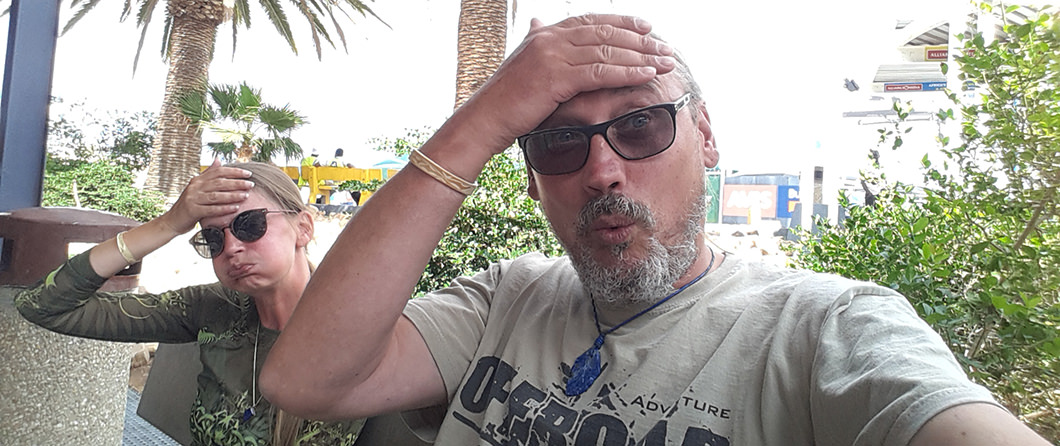
Shopping And Prices
Of course we didn't go shopping for fun and we didn't buy clothes or other knick-knackery, rather than only beverages, fresh vegetables, water and bread.
The prices are also depending on where you go.
In bigger cities Namibia got "SPAR" supermarkets, where you'll find a lot more stuff, than in other markets, like "Shop-Rite" or "Pick'n'Pay". The prices are higher (close to german pricing), but in the other mentioned markets it's really hard to get, what you're searching for, no matter if it's fruit or canned food.
And we always were wondering, what the common Namibian is eating 😀 )
We couldn't stand the Namibian meat and cold cuts.
Sometimes SPAR had some good cold cuts, but wherever we tried it: the meat has been so horrible, that we just had to throw it into the trash (I usualy NEVER throw away food!)
So we resigned most of the time Braai and ate Fennys loveley prepared and very well tasting salads.
Thank you my lovely, also a big thank you from my stomach 🙂
If you're a beer drinker, keep in mind, that selling alcohol is prohibited Saturdays, starting from 1p.m. until Sunday.
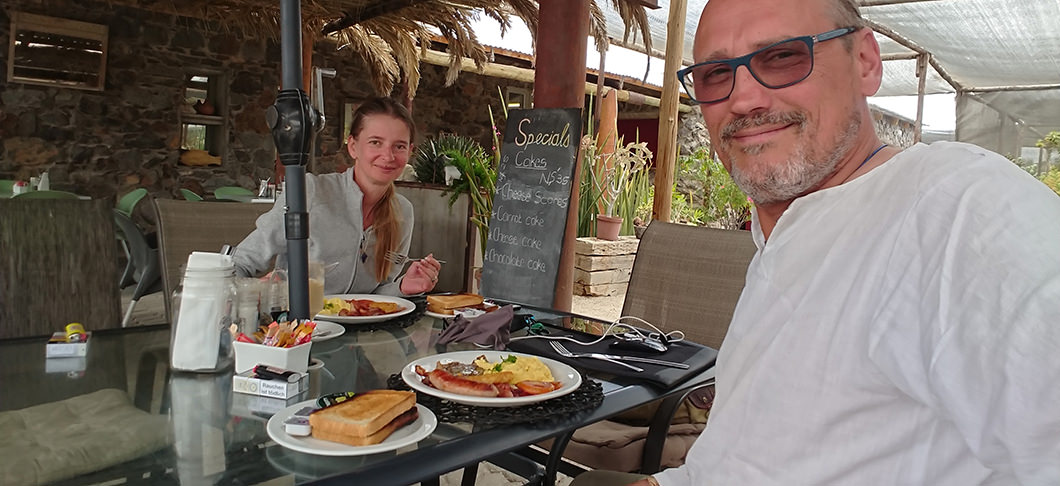
Our Recommendations - Must Sees and Must Visits
. Bwabwata-Nationalpark at the Botsuana/Namibia Border at the Caprivi strip.
. Gravel Road along the Cunene river from Ruacana to Epupa Falls.
. Etosha National Park.
. Namib-Naukluft National Park (Gamsberg Pass, Spreetshoogte Pass).
. Fishriver Canyon, Oranje river and Oranjemund (kind of offroad path to the ocean).
Could Do's
. Skeleton Coast (Ship wrecks and lunar landscapes).
. Hentis Bay and Cape Cross (Seals).
. Sossusvlei (Deadvleid and Hiddenvlei).
. Kalahari Desert (in direction of Botsuana).
Campsites - Highly Recommended
. NGepi Camp (Caprivi Strip at the Okavango Delta, Hippos at the campsite).
. Roadside Camp (at the Galton Gate of the Etosha Nationalpark, beautiful rocked surroundings with a waterhole).
. Camp Cornie (at the Cunene River... THE most beautiful paradise).
. Hais Ra Camp (Namib-Naukluft NP, camping under a rocked roof... stunning).
. Mariental River Camp (pragmatic, but kinda luxury and good for preparing for further trip).
. Spreetshoogte Camp (very basic, but the view is the best and just double WOW).
. Nauams Restcamp ("luxury" and absolutely lovely mountain camp between rocks, WOW).
. Harmony C28 Camp (simple but absolutely lovely and perfect for departure).
. Tiras Camping (mountain camping in the Tiras Mountains, lovely).
Facilities, Businesses and Camp Sites we DO NOT recommend
. Safari Car Rental (good cars, but very strange regulations, read here why).
. Hakos Guestfarm (very bad support, attracting guests without being able to offer anything, read our article).
. Mile 108 Camp (Skeleton Coast, 100s of noisy generators as well as 100s of campers, very bad ablutions).
. All Camps in Etosha (VERY overpriced)
. Arebush Camp Windhoek (only 4 totally rough and unlovely campsites, therefore overpriced).

Mandatory Things Like Passports, Visa, Malaria And General Health
There are not so much regulations for getting into Namibia, so there's just the travel passport you'll need and if you're planning to drive, then at least an english translated drivers license or an international license.
A special immunization isn't required, but keep in mind, that some parts of Namibia are Malaria areas, like in the very north.
We had a "Malarone" prophylaxis with us, which is supposed to be taken, when you're getting fever.
For getting Malarone just visit your vaccinator . He or she will explain you exactly how to use it and what to do in case of a Malaria infection.
In December we had very less mosquitos and we never did see a Tse-Tse or Anopheles fly, but it's always good wearing bright clothes as those bitches are attracted by the darker colors.
For repellents we always are using anything with at least 50% DEET, anything else never did work properly for us.
Please also take in mind, that distances are huge and not every village or city got a doctor. Namibia is divided in several classes which means, that only Windhoek has a doctor, smaller cities just have nurses or a very simple medical service. Villages won't have any of it, at best a medical advisory service.

We'll See Us Twice - In A Not So Distant Future 💙
All in all and after 5 weeks in Namibia, we can say, that we pretty much enjoyed this country, which is the reason for us coming back in a few weeks.
But this is a different story as we're now coming back for much longer... stay tuned 🙂
